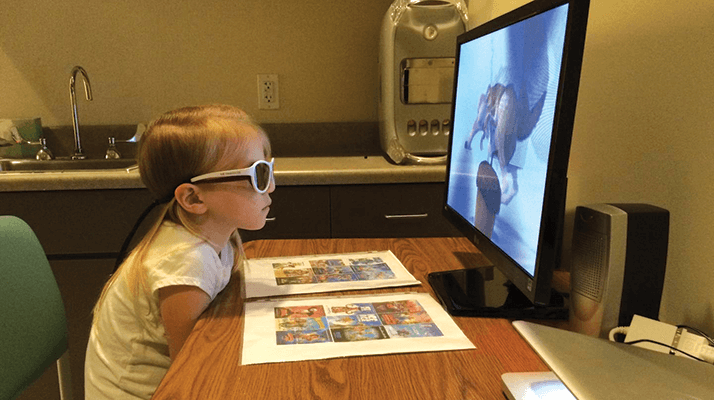
Many ophthalmologists are familiar with the concept of patching a child’s eye to treat amblyopia by forcing the brain to use the weaker eye. Some may even have experienced patching themselves. But this kind of treatment means that the dominant eye remains unused and the two eyes don’t work together. Researchers are now looking into more modern ways of treating the condition, including video games (1) – and now, a special type of movie. Dichoptic therapy uses both eyes at the same time. In the case of the movies, viewers wear special glasses that partially block the images presented to each eye, so that one eye “fills in the blanks” for the other. Additionally, the images sent to the dominant eye have reduced contrast to balance out image suppression in the weaker eye due to binocular dysfunction – meaning that children use binocular vision to see a complete picture.
Texas-based researchers recently conducted a study using the approach in eight children between the ages of four and 10. The children were shown dichoptic versions of popular children’s movies three times per week for two weeks – even after such a brief interval (nine hours in total), they showed one to four lines of improvement in visual acuity. The results were substantially better than those achieved with traditional patching techniques; according to lead author Eileen Birch, patching may require as much as 120 hours of treatment to achieve a single line of improvement, even after children have been treated with spectacles for several months (2). And there are benefits beyond the visual gains; many dichoptic techniques leave children bored or frustrated, increasing noncompliance, but combining therapy with animated films offers the chance to keep viewers engaged with their treatment. Obviously, this study is just the beginning – with only eight children tested and only nine hours of therapy, there’s a lot more work to be done before the results are confirmed. But if future successes are as clear-cut as the ones from the preliminary study, then dichoptic movies may offer a useful new option for treating amblyopia in the pediatric population.
References
- M Schubert, “Push, Pull, CHOMP!”, The Ophthalmologist, 11, 13 (2014). SL Li et al., “Dichoptic movie viewing treats childhood amblyopia”, J AAPOS, 19, 401–405 (2015). PMID: 26486019.
